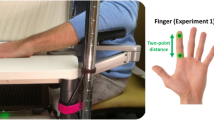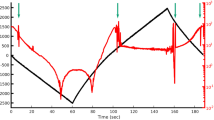Abstract
Outcome measures of vibratory sensitivity using a 256-Hz tuning fork depend on the perception of vibration by the patient and qualitative comparison with sensory threshold on the examiner. The authors present their experience of comparison of vibratory sensation using a 512-Hz tuning fork with the conventional 256-Hz counterpart in normal volunteers. The median visual analogue score achieved by the 512-Hz tuning fork was the same as the 256-Hz one in all the tested areas of the hand. The 512-Hz tuning fork is smaller and easier to carry and is more advantageous compared to the 256-Hz one. The authors strongly recommend the use of the 512-Hz tuning fork for the vibration sensitivity test.
Similar content being viewed by others
References
Burns TM, Taly A, O’Brian PC (2002) Clinical versus quantitative vibration assessment: improving clinical performance. J Peripher Nerv Syst 7(2):112–117, Jun
Hubbard MC, MacDermid JC, Kramer JF (2004) Quantitative vibration threshold testing in carpal tunnel syndrome: analysis strategies for optimizing reliability. J Hand Ther 17(1):24–30, Jan–Mar
Freeman C, Okun MS (2002) Origin of the sensory examination in neurology. Semin Neurol 22(4):399–407
Rosecrance JC, Cook TM, Satre DL, Goode JD (1994) Vibration sensibility testing in the workplace. Day-to-day reliability. J Occup Med 36(9):1032–1037, Sep
Thivolet C, El-Farkh J, Petiot A, Simonet C (1990) Measuring Vibration Sensations with graduated tuning fork. Diabetes Care 13(10):1077–1080
Pestronk A, Florence J, Levine T (2004) Sensory exam with a quantitative tuning fork. Neurology 1:461–464, Feb
Guyton AC, Hall J (2000) The nervous system: general principles and sensory physiology (unit 9). In: Guyton AC, Hall J (eds) Textbook of medical physiology (9th edn). Saunders, Philadelphia, pp 594–599
Author information
Authors and Affiliations
Corresponding author
Rights and permissions
About this article
Cite this article
Juma, A., Mandal, A. Vibration sensitivity testing with tuning fork—256 Hz or 512 Hz?. Eur J Plast Surg 30, 5–6 (2007). https://doi.org/10.1007/s00238-007-0125-y
Received:
Accepted:
Published:
Issue Date:
DOI: https://doi.org/10.1007/s00238-007-0125-y




